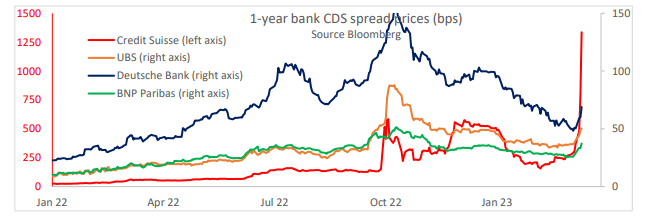MacroSlate Weekly: Bitcoin shines through banking failures, bailouts

Macro Highlights
- U.S inflation is too high for rate relief but mostly in line with expectations
- ECB raised a further 50bps taking their deposit facility rate to 3%
- Silicon Valley Bank files for chapter 11 bankruptcy
- Credit Suisse and First Republic Bank continue to be provided with liquidity
- Fed initiated stealth QE as balance sheet grows
Bitcoin Highlights
- Bitcoin hits $27,000, up roughly 60% YTD
- Bitcoin open interest has dropped by 15% in the past two weeks
- BTC dominates against Ethereum
- Bitcoin self-custody surges
Stealth QE and bailouts
Stealth bailouts
Credit Suisse grabbed a liquidity lifeline thrown by the Swiss National Bank and borrowed up to 50 billion CHF, the equivalent of 6.25% of the Swiss GDP. Credit Suisse’s share price has tanked roughly 20% this week while its default swaps continue to blow out.

It’s not just Credit Suisse who were provided a lifeline; First Republic Bank’s (FRB) share price has dropped 78% in the past month. News was announced that 11 big banks were helping FRB as they pledged $30 billion. However, the stock continued to slide into Friday’s session.

Stealth QE
The fed balance sheet has increased by over $300 billion this week, which has jumped to $8.69 trillion, wiping out half the quantitative tightening the fed has been doing for the past year.
The increase in the balance sheet is from the program BTFP; in layman’s terms, this allows institutions to swap devalued assets for full-value cash. In addition, the fed’s discount window went parabolic to $148 billion this week, the highest level since 2008. Again, in layman’s terms, distressed banks call for fed liquidity.
Balance sheet growth
- Approximately +$148.3 billion – net discount window borrowing.
- Approximately, +$11.9 billion – the new Bank Term Funding Program
Subtotal: $160.2 billion
- Approximately +$142.8 billion – borrowing for banks seized by FDIC Total:
This totals = $303 billion

ECB hikes 50bps ignores forward guidance
ECB hiked 50bps for the third consecutive session, increasing its deposit facility rate to 3%. Just six months ago, the deposit rate was at 0. Lagarde and the ECB remain firm in their “commitment to fight inflation.”, which is “projected too high for too long.”
Forward guidance was removed, and no understanding of future moves, instead reiterated, “the elevated level of uncertainty reinforces the importance of a>






 Bitcoin
Bitcoin  Ethereum
Ethereum  Tether
Tether  USDC
USDC  TRON
TRON  Dogecoin
Dogecoin  Cardano
Cardano  Bitcoin Cash
Bitcoin Cash  Chainlink
Chainlink  LEO Token
LEO Token  Stellar
Stellar  Zcash
Zcash  Monero
Monero  Litecoin
Litecoin  Hedera
Hedera  Dai
Dai  Cronos
Cronos  OKB
OKB  Tether Gold
Tether Gold  Ethereum Classic
Ethereum Classic  KuCoin
KuCoin  Gate
Gate  Algorand
Algorand  Cosmos Hub
Cosmos Hub  VeChain
VeChain  Dash
Dash  Stacks
Stacks  Tezos
Tezos  TrueUSD
TrueUSD  IOTA
IOTA  Basic Attention
Basic Attention  Decred
Decred  Theta Network
Theta Network  NEO
NEO  Synthetix
Synthetix  Qtum
Qtum  Ravencoin
Ravencoin  0x Protocol
0x Protocol  DigiByte
DigiByte  Zilliqa
Zilliqa  Nano
Nano  Siacoin
Siacoin  Holo
Holo  Numeraire
Numeraire  Waves
Waves  Enjin Coin
Enjin Coin  Ontology
Ontology  Status
Status  Pax Dollar
Pax Dollar  BUSD
BUSD  Hive
Hive  Lisk
Lisk  Steem
Steem  Huobi
Huobi  NEM
NEM  OMG Network
OMG Network  Augur
Augur  Bitcoin Gold
Bitcoin Gold  Ren
Ren  HUSD
HUSD